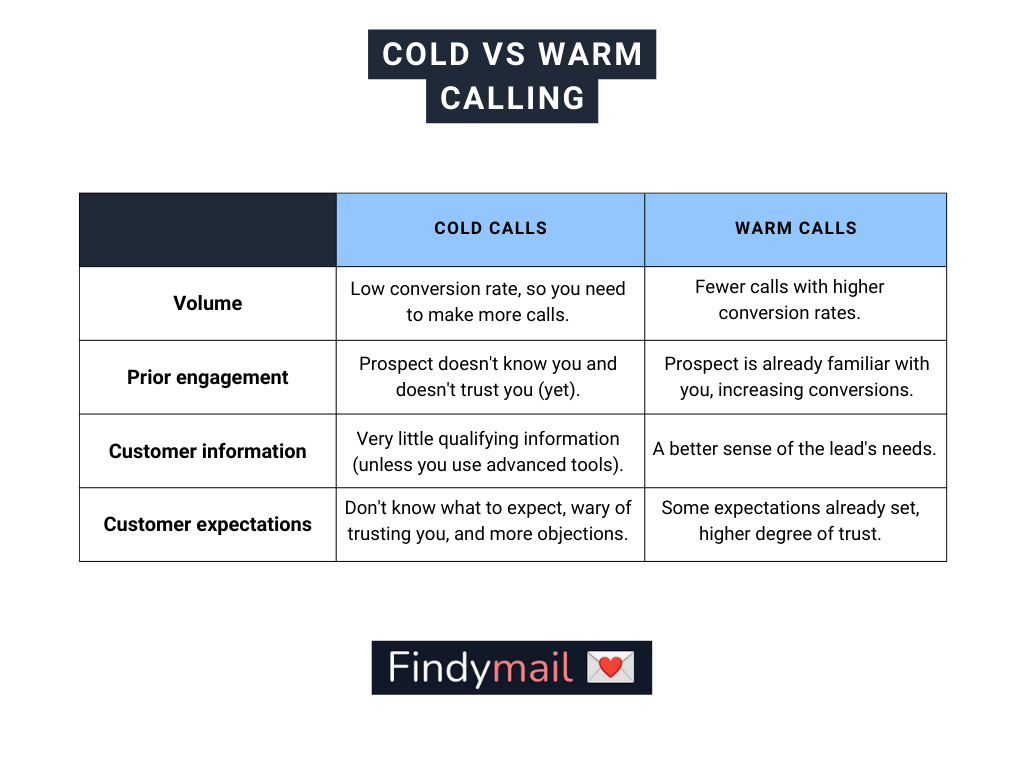You’ve likely hopped on a call with a prospect once or twice as part of your outbound sales strategy. But there’s a world of difference between talking to someone who has never heard of you and someone who’s shown interest, AKA: cold calling vs warm calling.
Today, we’ll outline the key differences between cold calling and warm calling so you choose the best solution for different use cases.
The Core Concepts: Cold vs Warm Calling
What Is Cold Calling?
Cold calling is contacting a potential customer who has never heard of your brand, products, or services. Typically, you’ll have a prospecting list, and your sales reps will start from the top. We refer to it as “a cold call” because the customer isn’t expecting the call.
Cold calling is a tried and tested outbound sales tactic because it allows sales reps to connect, engage with prospects, and get instant feedback. It does, however, have some challenges. For one, 90% of C-level executives, or in other words, decision-makers, simply don’t reply to cold calls.
Also, based on research conducted by Baylor University, it takes about 209 cold calls to schedule a single meeting. For most salespeople, cold calling isn’t efficient - although it can and should be if your prospecting list is fine-tuned.
What Is Warm Calling?
In contrast to cold calling, warm calling is when you contact a potential customer who’s already been warmed up, i.e. the customer is already aware of your products or services and has shown a definite interest in making a purchase.
Understandably, warm calling is more effective than cold calling and can significantly improve your success.
However, to get the highest success rate with warm calling, you need to do it right. So, you should:
- Not call your warm prospects repeatedly. When you call prospects repeatedly, you’ll only annoy them and, in doing so, reduce your chances of success. This is exactly the opposite of what you want. So, once you’ve made the call, it’s better to rather give them time to consider what you offer, or if they’ve given you a specific time frame, stick to it.
- Follow the call up with an email. It’s always a good idea to follow up on a call with a potential customer via email. The email should offer some value, such as how you can solve their problems or a targeted case study. This keeps you top of mind when they’re comparing different products or services and shows exactly what you have to offer.
- Practice active listening. Remember, warm prospects might have shown some interest in what you offer, but they’ve not decided yet. This means that, on the call, you should actively listen to their challenges and provide the solutions they’re looking for. Always listen more than you speak.
It’s also important to distinguish warm calling from hot calling. The last mentioned is when you call a potential customer who’s extremely interested in your products or services and is expecting the call. Compared to the other types of calls, hot calling offers the highest success rate.
The Difference Between Cold Calling and Warm Calling
Now that we have a broad overview of cold and warm calling let’s look at their specific differences.
The major difference between these two strategies is whether a customer has expressed an interest in a product or service. As mentioned earlier, with cold calling, they haven’t, and with warm calling, they have.
Flowing from this, there are several other differences in the way they impact the results you’ll be able to achieve.

Cold vs Warm Calling: Volume of Calls
As mentioned earlier, it takes plenty of phone calls to convert a single lead when you use cold calling as part of your outbound sales strategy. These phone calls also take a lot of time. As such, cold calling is not very efficient unless you’re aware it’s a numbers game. (This also means that it’s not cost-effective.)
In contrast, warm calling is more effective at converting leads.
Cold vs Warm Calling: Prior Engagements
When warm calling, you previously interacted with the client through an introductory call or information obtained from a form. In a sense, a relationship has already been established with the customer. This will automatically lead to a higher success rate, and you will be able to convert more leads.
Cold vs Warm Calling: Customer Information
This is where we get to the fun part!
Typically, when cold calling, you have little to no information about the customer. In any case, you don’t know and understand the customer’s challenges the way they see them. You won’t be able to offer solutions as quickly unless they’re willing to talk to you.
The best way to mitigate this cold-calling challenge is by refining your lead gen list. Instead of casting a broad net, use tools like LinkedIn Sales Navigator and then get prospects’ email addresses with Findymail.
At the end of the day, you should have a list of leads whose challenges you’re familiar with. For example, startup founders who raised Series B funding and invested heavily in growth marketing.
Conversely, when warm calling, a customer already has already shown interest in your products or services. Depending on your lead qualification process, you may have already gathered information on specific challenges they want you to solve.
Cold vs Warm Calling: Customer Expectations
Another major difference between cold and warm calling is that there’s a significant difference in customer expectations.
A customer who has had some interaction with your business before and that has an interest in your products or services will have entirely different expectations compared to a customer who’s never heard about your business before. They’ll trust you more, and they’ll be open to hearing out your proposed solutions.
In contrast, cold-calling prospects will be more hesitant to give you enough time to explain, so you have to have a strong hook.
Which Strategy Should You Use: Cold or Warm Calls?
Cold and warm calling are specific, each with its own (dis)advantages. However, don’t discount cold calls immediately. In the hands of experienced salespeople, they can be a powerful asset in your strategy.
And then, once you break the ice, let your warm calls seal the deal!






